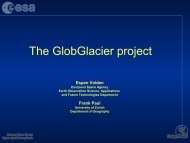proportion
Altai - GLIMS: Global Land Ice Measurements from Space
Altai - GLIMS: Global Land Ice Measurements from Space
- No tags were found...
You also want an ePaper? Increase the reach of your titles
YUMPU automatically turns print PDFs into web optimized ePapers that Google loves.
D16107SHAHGEDANOVA ET AL.: GLACIER AND CLIMATE CHANGE IN THE ALTAID16107Table 3. Reduction in the Combined Area of Glaciers (km 2 ) as a Function of Glacier Size ClassGlacier size Combined area in 1952 Combined area in 2004 Area loss (km 2 ) Area loss (%)/st. deviation>5 108.7 90.7 18.1 16.7/6.95‐2 79.0 68.0 11.1 14.0/14.61–2 52.5 38.3 14.2 27.1/16.40.5–1 45.1 32.5 12.6 27.8/16.1size of the examined glaciers is 1.4 km 2 on the southernslopes of both ridges and 1.9 km 2 and 2.0 km 2 on thenorthern slopes of the North and South Chuya Ridgesrespectively.[22] The valley glaciers exhibited the largest absolutecombined reduction in surface area (Table 4). The highestaverage loss per glacier characterized cirque‐valley glaciersshrinking at an average rate of 0.08 km 2 a −1 per glacier.They also exhibited the largest relative area loss. It is thetongues of the cirque‐valley glaciers that retreated rapidlywhile sectors resting in cirques experienced less change. Thecirque glaciers lost smaller <strong>proportion</strong> of their surface areaas their regime is strongly controlled by shading, snow driftand avalanche nourishment allowing them to survive underthe climatic warming and even below the mean climaticELA [Kuhn, 1995].4.2. The Observed Climate Variations and FutureClimate Change Scenarios[23] The positive trends in JJA air temperatures betweenthe mid‐20th century and 1994 particularly below 2000 melevation has been reported by Narozhny and Adamenko[2000]. At the Akkem station (2056 m a.s.l.; Figure 5a), apositive linear trend explained 25% of the total variance inthe record in 1950–2004 yielding a temperature increase of1.26°C. Following the negative anomalies observed in the1980s, the warming intensified between 1985 and 2004 withthe JJA temperatures increasing at a rate of 0.10°C a −1 andlinear trend explaining 61% of the total variance. At Kara‐Tyurek (2600 m a.s.l.), the long‐term trend was weakeryielding a temperature increase of 0.87°C in 1940–2004 butin the last twenty years the JJA temperatures were increasingat 0.13°C a −1 (Figure 5c). At Kara‐Tyurek, annual precipitationincreased slightly since the 1950s with a linear trendexplaining 14% of the total variance but at Akkem annualprecipitation exhibited considerable variability but no significantlinear trend (Figures 6b, 6d).[24] Prior to the interpretation of regional climate changescenarios, model validation has been performed using datafrom five meteorological stations located between 48–50.5°Nand 86–89°E for the 1961–1990 period. The gridded observationaldata sets have no advantage over individual stationsfor the purpose of model validation in the study area becausethere are few high‐altitude stations. The average altitudes ofmodel validation domain and of the stations were 2240 m and2140 m a.m.s.l. respectively. The observed and modelled airtemperatures are in close agreement throughout the year. Insummer, the model overestimates monthly temperatures by0.6–0.9°C (Figure 6a) possibly due to the under‐representationof local convection and cloud cover.[25] Precipitation intensity is most relevant for snowaccumulation but it is one of the most challenging variablesfor simulation by both RCM and statistical downscaling[Schmidli et al., 2007]. The model reproduces annual cycleof precipitation intensity but modelled values exhibit positivebias between October and May while the July–Septemberprecipitation is underestimated (Figure 6b). BetweenNovember and March, the modelled values of precipitationintensity exceed the observed by 13% in January and30–33% in other months. In the months when most of snowaccumulation occurs, this difference is lower: 17–26% inApril–May, and 9% in October. There are two likely sourcesof this discrepancy: (i) undercatch of precipitation by theTretyakov gauges and (ii) overestimation of the westerlyflow and consequently precipitation by the model. Anaverage wind‐induced undercatch of precipitation betweenNovember and March is 19–20% and in October, April,and May is 16–18% at the elevation of 2380 m a.s.l..The level of uncertainty implied by the use of uncorrectedobserved precipitation is close to the discrepancy betweenthe observed and modelled precipitation intensity in coldseason. A secondary source of discrepancy is a negativebias characterising the modelled sea level pressure (SLP) inthe study area. A comparison between the 30‐year (1961–1990) averages of December–February (DJF) SLP from thePRECIS simulation and from ERA 40 reanalysis [Uppala etal., 2005] has shown that while the Siberian high, thatdominates northern Asia in winter is reproduced by themodel, the modelled high pressure area is shifted towardsnorth–east. As a result, the 1961–1990 average of the DJFSLP is underestimated by the model by 7–10 hPa in thesouth–western part of the modelling domain extending toeastern Kazakhstan and the western Altai. This negative biasin the modelled SLP results in an overestimation of thewesterly flow over the Altai leading to an overestimation ofwinter precipitation. Similar biases in RCM simulationsof SLP have been reported by Giorgi et al. [2004] for theEurasian continental areas. The bias in the simulated SLP islower in January than in November–December and February–March. As a result, the difference between the modelled andthe observed precipitation intensities in January is the lowestin the cold season and is very possibly due to the precipitationundercatch entirely. The discrepancy between theobserved and modelled precipitation in October, April andMay, when the atmospheric circulation is not affected by theTable 4. Area Reduction for Different Types of Glaciers (WithIndividual Areas not Less Than 0.5 km 2 in 1952) aGlacier type Number Average size, km 2 Area loss, km 2 Area loss, %Valley 56 2.8 34.8 18.2Cirque‐valley 40 1.1 16.9 27.7Cirque 18 0.8 2.7 16.3Flat‐summit 4 0.9 0.3 7.4Hanging 7 0.6 0.7 14.4Crater 1 6.4 0.6 9.6Total/average 126 1.8 56.0 19.7a The average sizes of glaciers refer to 2004.7of12





